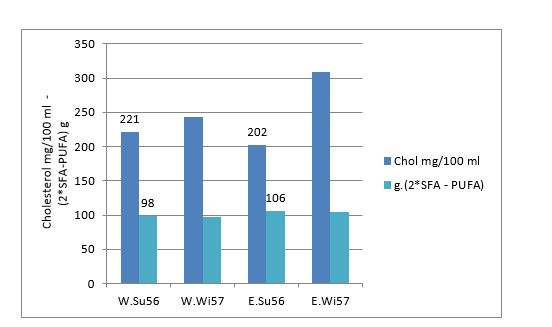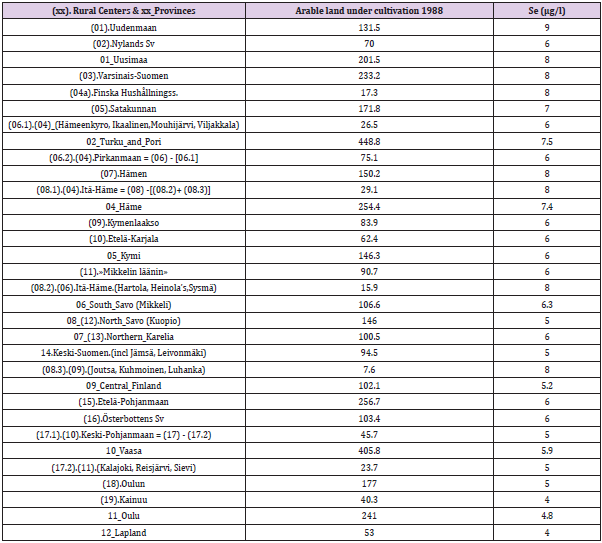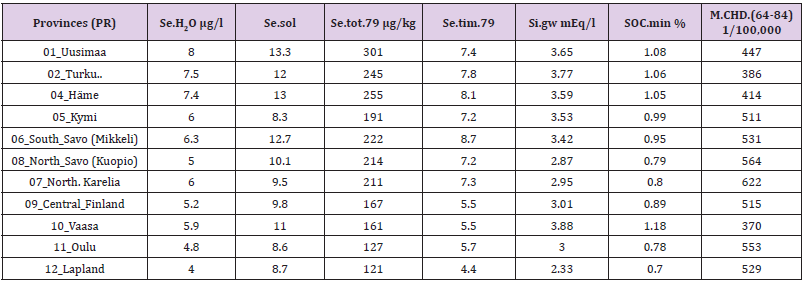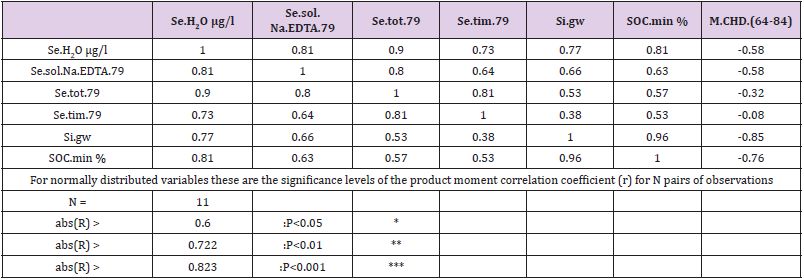ABSTRACT
Introduction: The casual low cholesterol in the East Finland in June 1956 has been discussed earlier. It was not explained by the value of cholesterogenic formula, but better by silicon (Si), magnesium (Mg) and climatic factors. This revised article tries to explain the eastern low cholesterol from 1956 via agricultural soil selenium (differently extracted: [Se.(H2O)], [Se.sol], [Se.tot]), timothy Se [Se.tim.79] from pre- Se-fertilization period, groundwater Si [Si.gw], soil organic carbon of mineral soils [SOC.min(61-70)] and mortality from CHD.(64-84).The statistical data are as such or adjusted by provinces (N = 11) from old sources. Hot-water-extractable Se are from 3 years, N=1340, generally autumnally collected. Other Se samples are from a prospective study from June 1979 (N=250). Mortality of middle-aged men from coronary heart disease (CHD) works as a risk indicator of ASO.
Results: Associations (r) of [Se.H2O] were higher to the respective associations of [Se.sol] with the following parameters: [Se.tot] (0.90***/0.80**), [Se.tim] (0.73**/0.64*), [Si.gw] (0.77**/0.66*), [SOC.min] (0.81**/0.63*). [Se.tim] associated slightly stronger with [Se.tot] than with [Se.H2O]. Significances and associations with [Si.gw] and [SOC.min] decreased in order (/): [Se.H2O] (**/**) > [Se.sol] (*/*) > [Se.tot] (0.53(*)/0.57(*)) > [Se.tim] (0.38ns/0.53(*)). CHD was explained (r) significantly by [Si.gw] (-0.85***) and [SOC.min] [-0.76**), nearly significantly by [Se.H2O] (-0.58(*)) and [Se.sol] (-0.58(*)), non-significantly by [Se.tot] (-0.32ns) and [Se.tim] (-0.08ns).
Conclusions: High (autumnal) correlation of [Se.H2O] with [Se.tot] was possibly associated with depot function of humus. Slightly higher correlation of [Se.sol] with [Se.tot] is not surprising, because [Se.H2O] samples were collected from the respective provinces, but from different fields, in different seasons¬¬. Environmental factors can have a role in the regional atherosclerosis, even inside of the known risk factors. Seasonal variation in milk fat composition will be assessed later.
Keywords: (Dietary lipids,) serum cholesterol, Si, Se, weathering, soil organic carbon.
Abbreviations: CHD: Mortality from Coronary Heart Disease (of 35-64 y old men, 1/100,000); Mg: Magnesium; Se: Selenium; [Se.H2O]: Hot Water Extractable Se; [Se.sol]: Soluble Se (explained in text); [Se.tim]: timothy Se; [Se.tot]: Total Se; Si.gw: Groundwater Silicon; [SOC. min]: Soil Organic Carbon of Mineral Soils (from 1961-70).
Introduction
The old textbooks of biochemistry wrote that polyunsaturated fats (PUFA) decrease blood cholesterol content. Some experiments support the theory, that PUFA’s can even protect against atherosclerosis (free abbr. ASO). Keys et al have developed dietary “cholesterogenic formula” for prognosticating serum cholesterol and development of ASO. The aim of this article is to find explanation to the eastern summer cholesterol 5.2 mmol/l, which is 9 % lower to the respective western value, although same time the cholesterogenic index in east was 8 % higher to its respective western value (Table 1). Serum (total) cholesterol (mmol/l) was in summer 9 % lower (E/W ratio 0.91) and in winter 27 % higher than in west. Winter values in west were 10 % and in east 53 % higher than in summer [1]. Values of cholesterogenic formula (g) [2*saturated fatty acids (SFA) – polyunsaturated fatty acids (PUFA)] were 8-9 % higher in east than in east. Their winter values were 1-2 were lower to their summer values. Summer-winter means of cholesterol and cholesterogenic formula were 8-10 % higher in east. (Cholesterol values mg/100 ml are divided by its molar weight 386,7 g/mol and multiplied by 10). Especially summer cholesterol of the east, 5.2 (mmol/l), is in disagreement with the high value of the cholesterogenic formula (105.8), cf. cholesterol of the west (5.7) with value of the cholesterogenic formula 98.1. Seasonal variation in cholesterol was 10 % in the west, but 42 % in the east [2]. Because cholesterol can be seen as an inflammation marker and inflammation can be seen as a causative factor of coronary heart disease, here mortality from CHD has been benefited as an indicator on possible cholesterol associations (Figure 1). Cholesterol levels are dependent on inflammation, TNF-alfa and IL-6 [3].
Low serum and milk silicon (Si) content has been associated with inflammation [4]. Low daily intake of magnesium (Mg) is reported to be associated with elevated CRP in humans [5]. Mg (Mg deficiency) can increase serum cholesterol level by controlling HMG CoA reductase [6]. Additional Si [7] or selenium (Se) [8] can decrease serum cholesterol level. Weathering of Mg and Si from soil silicate matrix, which occurs e.g., via fungal and bacterial assistance [9,10], is temperature dependent and starts somewhat later than K liberation [11]. This explains why generally Mg availability via grass is the lowest in the spring [12]. Additionally, temperature of May 1955 was 1-3 degrees lower to the average. Precipitation in June was unusually high in the Southwest Finland (Åland and Lapland) and less to average in other provinces [13]. Rainy weather can increase K contents and decrease Mg contents of plants [12]. High precipitation could dilute the weathered Mg and Si. So, in Jun 1955 the weather conditions could promote more Si and Mg access in East than in West. Less rain in East could be associated with higher amount of sunshine, synthesis of vitamin D and possible antidepressive effects, with possible metabolic effects. Total selenium (Se.tot) (μg/kg), “soluble” Se [Se.sol] (μg/l) and timothy Se content [Se.tim] μg/kg are from [Sippola,[12]]. [Se.tot] was extracted by several acids (HF, HNO3, HClO4 and HCl), in special order and heating. [Se.sol] was extracted with acid ammonium acetate-0.02 M Na2EDTA solution. [Se.tim] extraction is explained in [Sippola [12]]. [Se.H2O] from 1978-80 are provided by Viljavuuspalvelu Oy. Extraction was as follows: Dry and milled soil sample was extracted with boiled water at ratio 1:3. Leachate was analyzed using CV-AAS equipment (Kalevi Koivunen, Eurofins Viljavuuspalvelu Oy (Tables 2-4) [13-25].
Figure 1: Shows the great variation in eastern cholesterol values and association of its low summer value with the highest value of cholesterogenic formula (2*SFA-PUFA).
References
- Keys A, Karvonen MJ, Fidanza F (1958) Serum-cholesterol studies in Finland. Lancet 2: 175-178.
- Roine P, Pekkarinen M, Karvonen MJ, Kihlberg J (1958) Diet and cardiovascular disease in Finland. Lancet 2: 173-175.
- Keys A, Anderson JT, Grande F (1957) Prediction of serum-cholesterol responses of man to changes in fats in the diet. Lancet 273(7003): 959-966.
- Turpeinen O, Karvonen MJ, Pekkarinen M, Miettinen M, Elosuo R, et al. (1979) Dietary prevention of coronary heart disease: the Finnish Mental Hospital Study. Int J Epidemiol 8(2): 99-118.
- Anon (1970) What is the question in the fat dispute? (“Mistä on kysymys rasvariidassa”) [in Finnish]. Karjatalous 09/1970, Valio. (Fat quality was not the only difference between the groups: The butter group got about double dose of sugar to soya oil group), pp. 378-381.
- Memon RA, Grunfeld C, Moser AH, Feingold KR (1993) Tumor necrosis factor mediates the effects of endotoxin on cholesterol and triglyceride metabolism in mice. Endocrinology 132(5): 2246-2253.
- Parantainen J, Tenhunen E, Kangasniemi R, Sankari S, Atroshi F (1987) Milk and blood levels of silicon and selenium status in bovine mastitis. Vet Res Commun 11(5): 467-477.
- King DE, Mainous AG, Geesey ME, Woolson RF (2005) Dietary magnesium and C-reactive protein levels. J Am Coll Nutr 24(3): 166-171.
- Weather conditions [in Finnish Sääolot] 1.7.1955 – 30.6.1956, on p. 66. Mitä Missä Milloin 1957. kustannusosakeyhtiö Helsinki 1956.
- Kurki M (1982) Suomen peltojen viljavuudesta III. Viljavuuspalvelu Oy. Helsinki 1982. Pariset Oy ISBN 951-99399-0-3. (Fig. 73, on p. 90).
- Kalevi Koivunen, Eurofins Viljavuuspalvelu Oy (personal communication).
- Sippola J (1979) Selenium content of soil and timothy (Phleum pratense L.) in Finland. Annales Agriculturae Fenniae 18: 182-187.
- (1990) SVT (Official Statistics of Finland). Land use on farms by Agricultural Advisory Centre according to municipality 31.12.1988. Maa-ja Metsä Agriculture and forestry. Maatilarekisteri. Farm register 1988. Maatilahallitus. National Board of Agriculture, Helsinki, p. 54-65.
- Rosanoff A, Seelig MS (2004) Comparison of mechanism and functional effects of magnesium and statin pharmaceuticals. J Am Coll Nutr 23(5): 501S-505S.
- Garcimartín A, Santos-López JA, Bastida S, Benedí J, Sánchez-Muniz FJ (2015) Silicon-Enriched Restructured Pork Affects the Lipoprotein Profile, VLDL Oxidation, and LDL Receptor Gene Expression in Aged Rats Fed an Atherogenic Diet. J Nutr 145(9): 2039-2045.
- Kang BP, Bansal MP, Mehta U (1998) Selenium supplementation and diet induced hypercholesterolemia in the rat: changes in lipid levels, malonyldialdehyde production and the nitric oxide synthase activity. Gen Physiol Biophys 17(1): 71-78.
- Henderson MEK, Duff RB (1963) The release of metallic and silicate ions from minerals, rocks, and soils by fungal activity. J Soil Sci 14(2).
- Frey B, Rieder SR, Brunner I, Plötze M, Koetzsch S, et al. (2010) Weathering-associated bacteria from the Damma glacier forefield: physiological capabilities and impact on granite dissolution. Appl Environ Microbiol 76(14): 4788-4796.
- Malmström M, Banwart S (1997) Biotite dissolution at 25°C: The pH dependence of dissolution rate and stoichiometry. Geochimica et Cosmochimica Acta 61(14): 2779-2799.
- Kuusela E (2006) Annual and seasonal changes in mineral contents (Ca, Mg, P and Na) of grazed clover-grass mixtures in organic farming. Agricultural And Food Science 15: 23-34.
- Ebrahimi N (2020) Selenium biofortification in crops and its cycling in the agroecosystem. DOCTORAL THESIS. Department of Agricultural Sciences, Faculty of Agriculture and Forestry, University of Helsinki. (p. 34: cool & damp weather).
- (1990) SVT (Official Statistics of Finland). Land use on farms by Agricultural Advisory Centre according to municipality 31.12.1988. Maa-ja Metsä Agriculture and forestry. Maatilarekisteri. Farm register 1988. Maatilahallitus. National Board of Agriculture. pp. 54-65. Helsinki 1990. ISSN 0785-7500. Map of Rural Centers on p. 19.
- Peruskoulun Karttaopas. pp 32-33. graphics Tiainen H. Maanmittaushallitus. Helsinki 1985.
- Lahermo P, Tarvainen T, Hatakka T, Backman B, Juntunen R, et al. (2002) Tuhat kaivoa - Suomen kaivovesien fysikaalis-kemiallinen laatu vuonna 1999. Summary: One thousand wells - the physical-chemical quality of Finnish well waters in 1999. Geological Survey of Finland, Report of Investigation 155. 92 p. Groundwater database of Geological Survey of Finland 2013.
- Kurki Martti (1972) Suomen peltojen viljavuudesta II. Tabl. 13 on p.134.Viljavuuspalvelu Oy. Helsinki 1972. Yhteiskirjapaino Oy.

 Review Article
Review Article




